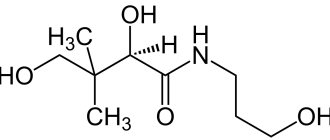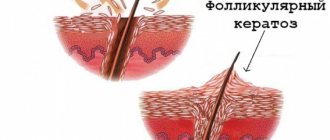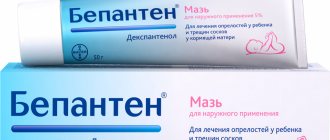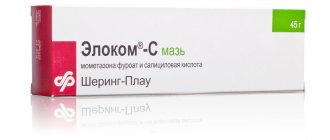Skin xerosis – abnormal dryness of the upper layer of the skin, caused by changes in the hydrolipid balance of the skin. It manifests itself as a dry, rough structure of the surface of the skin. The skin becomes cracked, inflamed, and infected. With the disease, the entire spectrum of pathological skin changes is observed: disturbances in sebum secretion, sweating, skin lipids, amino acid deficiency, and a feeling of discomfort. The condition is constantly accompanied by itching, which reduces the patient’s quality of life.
Causes
The main mechanisms for the development of dryness and flaking of the skin are a violation of its acid-base balance, poor functioning of the sebaceous glands, too frequent renewal of the upper layer of the epidermis and moisture deficiency in the epithelium.
The reasons may be: external influences, various diseases - both dermatological and general, and the general condition of the body. Of the external factors that have an adverse effect on the skin and cause dry skin, the most significant are the following:
- exposure to aggressive substances;
- chapping, hypothermia or overheating of the skin (for example, a sauna);
- improper skin care;
- exposure to ultraviolet radiation, especially in combination with weathering, or prolonged contact with an alkaline environment (for example, staying on the beach by the sea);
- regular exposure to hot or extremely cold water, especially chlorinated water.
Dry and flaky skin can be symptoms of the following diseases: allergic reaction; acquired, hereditary or congenital skin diseases, including psoriasis, seborrhea, eczema, atopic dermatitis, ichthyosis; diseases of bacterial, viral, inflammatory, hereditary and other etiologies. Dry and flaky skin may indicate the presence of: endocrine diseases (hyper- or hypofunction of the thyroid gland or adrenal glands, diabetes mellitus); problems with the digestive tract (gastritis, duodenitis, cholecystitis); metabolic disorders; some neurological ailments (migraine, autonomic-vascular dysfunction, neuralgia, neuroses, depression); damage to the endocrine system and other diseases requiring treatment. The most common cause of the development of xerosis is poor nutrition and, as a result, a lack of minerals and vitamins in the body. Spring peeling of the skin, often mistaken for an allergy, is in fact most often a manifestation of a lack of vitamins in the body. It is dull, dry and flaky skin that in most cases is the first symptom of vitamin deficiency A, E, B1 and C. Interestingly, a deficiency of vitamin B6 manifests itself on the contrary, with oily skin prone to acne formation. Dry hand skin may indicate a lack of vitamins A, E, B7 and D. Dry and flaky skin can also be caused by a lack of minerals (zinc, magnesium) and Omega 3 (polyunsaturated fatty acids).
Prevention of dry body skin and moisturizing methods
When the first signs of dry skin appear, further development of this disease should be prevented. To do this, just follow some rules:
- Skin that is naturally dry must be moisturized with cosmetic creams that contain lecithin, collagen and propolis. Creams containing hyaluronic acid and other vitamins and minerals will also help. But moisturizing creams should not be overused, since with frequent use the skin will completely lose its ability to retain moisture on its own;
- People with a predisposition to dry body skin should treat it more carefully and not use aggressive scrubs. After water procedures, you should lubricate your body with a rich cream;
- Dry skin, in addition to moisturizing, must be nourished with useful substances. And remove exfoliated skin from the body;
- Also equally important is the correct selection of clothing and shoes; it is best to wear shoes only made from natural materials, and clothing should not contain large amounts of synthetics, especially underwear;
- Use humidifiers in the house, and in the car it is better to set the climate control to 85% humidity.
Symptoms
Most often, dry skin is a temporary problem that only bothers you during a certain season, but it can last a lifetime. Symptoms of xerosis depend on your general health, age, where you live, and how much time you spend outdoors. Possible symptoms include:
- Feeling of tightness of the skin, especially after a bath.
- The skin is wrinkled and dehydrated.
- The skin looks rough instead of smooth.
- The itching is disturbing, sometimes very intense.
- Peeling of the skin - from slight to severe.
- Cracks in the skin, sometimes bleeding and painful.
- Redness of the skin, usually in limited areas.
Why does the skin need water?
Moisture ensures skin elasticity, firmness and nourishment of skin cells. The level of hydration depends on the condition of the upper layer of skin and the amount of sebum secreted. These two factors are responsible for moisture exchange. Fat and the moderate stratum corneum form a lipid film on the skin; this film prevents moisture from leaving the skin and the environment from greatly influencing the condition of the inner skin. The absence or weakening of the lipid film, caused by age or external aggressive environmental factors, leads to excessive evaporation of moisture, and therefore to dry skin. It also negatively affects blood microcirculation and skin ventilation. Due to the lack of the required amount of moisture, the skin becomes dry and flabby.
Treatment
Methods for moisturizing the skin are different and are largely determined by eliminating the source - the catalyst of the problem. If the cause is a specific disease, then treatment of dry skin of the body includes all the necessary measures that can stop the pathology, and hence remove its accompanying symptoms.
If the reason is different, then it is necessary to take measures to protect the skin from the negative influence of external irritants, which can be eliminated independently. It is necessary to keep the skin clean, but you should not overdo it with the amount of washing and taking baths and showers. Cosmetics for washing must be of high quality and match your skin type. You should use only high-quality, non-expired cosmetics. In winter, it is necessary to use protective creams. In everyday life, prefer clothes and shoes made from natural materials. This will protect against the occurrence of allergic reactions to artificial material and protect against thermal overheating of the skin. Anti-inflammatory agents must be used along with moisturizers. It is recommended to use anti-allergy medications or general health-improving medications internally, which will be prescribed by your dermatologist.
Film-forming humecants
Film-forming humecants include glycerin, fats, waxes and mineral oils. They form a protective film on the surface of the skin and thus prevent excessive evaporation of moisture. Glycerin can be called the strongest of the film-forming humecants, but it not only retains moisture well, but also stimulates the process of creating young skin cells. A large number of new cells maintains water balance in all layers of human skin.
Also, hexahydric alcohol sorbitol has special properties, which not only perfectly moisturizes the skin, but also forms a film that prevents moisture evaporation.
Another popular remedy for combating dry skin is linoleic acid, which, in addition to creating a waterproof film, regulates the permeability of the epidermis.
If you notice symptoms of dry body skin, consult a dermatologist, because this disease may be caused by more complex and dangerous diseases.
Cosmetic procedures for peeling facial skin
If your face is peeling due to insufficient care, you should contact a cosmetologist who will recommend suitable products and procedures. Depending on the degree of the problem and skin type, the following may be carried out:
- different types of peeling, excellent for removing particles of dead epidermis from the face;
- mesotherapy is a procedure for introducing hyaluronic acid, vitamins, microelements, amino acids and other agents under the skin to stimulate cell renewal and saturate them with useful substances;
- various intensive hydration programs;
- facial massage using moisturizing and nourishing products, which helps improve natural blood microcirculation and, as a result, supply the skin with nutrients from the inside.
When turning to a cosmetologist for help, it is important to realize that skin care procedures will only help if the cause of peeling does not lie in health problems.
Mistakes in caring for dry skin
Not everyone understands how to care for dry skin. Of course, dryness is aggravated due to sea and chlorinated water, natural factors such as wind, cold, dry air, exposure to ultraviolet radiation, as well as a deficiency of vitamins A, B, E. But some reasons are related to a person’s lifestyle. Check if you are making any mistakes:
- often go to the solarium or to the beach,
- have bad habits: alcohol, smoking, caffeine addiction,
- wash your face with hot water or take an excessively hot bath,
- do strong peelings or use cleansing masks,
- use alcohol lotions and alkaline soaps,
- limit yourself in every possible way in your diet,
- You don't moisturize your skin at all.
Proper care and a healthy lifestyle will relieve your skin of tightness, flaking and discomfort. But incorrect care for very dry skin will only worsen its condition.
Care - basic rules
There are recommendations both for specific types and general ones. For any skin, it is important to carry out daily care in three stages:
Cleanse. Washing with any product. Twice, morning and evening. Prepares the epidermis for the second stage. It is better to carry out with water at room temperature.
Tone. Residues of cleanser are removed and pores are narrowed. A tonic is used.
Moisturize. The cream is necessary to maintain the skin's natural moisture level. It is best to choose a cream with ultraviolet protection (SPF from 30).
Features of seasonal skin care
Daily care for dry skin is the main guarantee of freshness and tone at any time of the year. However, specific care is largely related to humidity, temperature and other weather conditions.
in winter
During this period, the most dramatic temperature changes begin: it is cold and windy outside, and the air at home is hot and dry. Therefore, the skin dries out even more and needs intensive care. Apply the cream daily, and at least half an hour before leaving the house, use skincare products so that they are better absorbed.
in spring
In the first half of spring, frost and wind persist, and therefore intensive protection is still important. Products with a lighter texture are suitable. It’s also worth buying a cream or lip balm: they need care all year round, but in the spring they become chapped especially badly.
In summer
In summer, ultraviolet radiation has a particularly strong effect on the skin. Use skincare products for regeneration (for example, with aloe vera extract) and moisturizing: it is best to apply it in the evening.
in autumn
After a hot summer, skin care is especially important: it suffers from increased dryness. We need to prepare her for the coming cold weather. At this time, nourishing and moisturizing products are suitable.
Skin type test
A professional cosmetologist in a clinical setting can easily determine what type of skin you have using a device called a dermatoscope. You can try to determine your type yourself. There are several ways to do this.
Method 1
Clean your face and do not apply makeup. After two hours, notice how your skin has changed:
- Normal. The shade does not change, there is no feeling of tightness or greasy shine.
- Dry. Tightness or flaking, which can be eliminated with a rich cream.
- Combined. The T-zone and cheeks are shiny.
- Fat. It acquires shine over the entire surface.
Method 2
As in the first case, you need to wash your face and wait 2 hours without applying any makeup. Next, a thin napkin is pressed tightly to the face. Your type is determined by traces of sebum:
- Fat. Imprint of sebum on all areas.
- Dry. There are no stains left on the paper. Skin particles may remain.
- Mixed. Marks in the T-zone, sometimes also on the forehead and/or chin.
- Normal. Minimal traces.
Both of these methods are as unreliable as they are simple. It is important to understand that you can make a mistake and harm yourself with the wrong care.
Other leather characteristics
In addition to this division into types, there are other categories of types of epidermis. Cosmetologists highlight the skin:
Problematic. This type most often occurs during puberty, from fourteen to twenty-five years. Characterized by various inflammations, acne, etc.
Mature. It is characterized by noticeable age-related changes, the presence of wrinkles around the eyes and on the forehead, the appearance of nasolabial folds, and drooping of the facial contours (also called ptosis).
Sensitive. Allergic skin, prone to irritation, itching, burning.
Cooperose. It is distinguished by visible capillaries located close to the surface.
How to care for dry skin
Rules for caring for dry skin involve internal and external effects on the body. You should add to your diet dishes with vitamin E (radish, nuts, corn), A (fish oil, broccoli, tomatoes), and group B: fish, dairy products, bread.
It is also important to take care of the outside of your skin. Use special products regularly: they have a cumulative effect, so interrupting care is not recommended.
- Always cleanse your skin of makeup.
- Use skin care creams not only for your face, but also for your hands and feet.
- You need to moisturize your skin twice a day: in the morning (at least half an hour before going outside) and in the evening, an hour before bedtime.
- During sleep, skin cells are restored, and due to lack of sleep, the barrier function deteriorates, hydration decreases, and tone changes. So don't neglect your sleep.
Dry patches with scales
Pink, raised, dry patches on the body and head may indicate psoriasis. With this dermatological pathology, raised plaques appear on the skin of a person - psoriatic papules. They protrude above the surface of the skin, cause intense itching and flake, and tend to spread and coalesce.
Psoriasis is a chronic autoimmune disease in which rashes are most often localized on the elbows, head, knees and groin. Dry pink spots covered with white scales are foci of chronic inflammation. Under the influence of internal autoimmune processes, epidermal cells divide several times faster than necessary. As a result, small flakes of dying skin cells are constantly separated.







